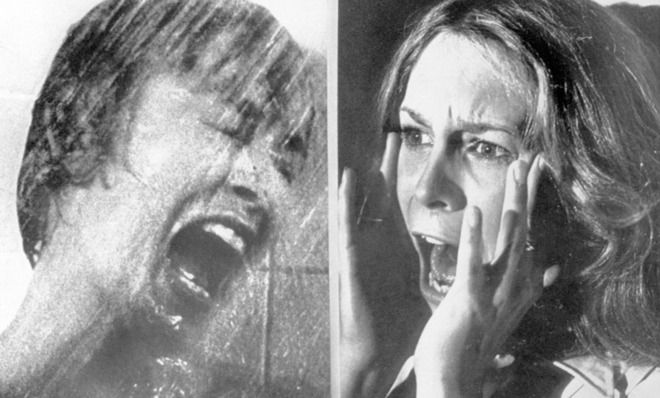How science can help you survive scary movies
Taking control of "bump in the night" anxieties is possible — but it definitely isn't easy


My mother's favorite story to tell in October features me as a 3-year-old, sitting down to breakfast at a local diner. The restaurant's walls and windows were bedecked with Halloween cutouts — think cartoonish ghosts, goblins, and, of course, vampires. I took one look at Dracula and went into a full-blown meltdown, so my mom's friend hurried over and covered him up with a napkin.
Upon her return, I leaned over and whispered, "I can still see his toes."
I wish I could say I've outgrown these anxieties about all things that go bump in the night. Alas, my Halloween nerves are as fragile now as they were then. So I set out to finally confront my fears, with a little help from science.
The Week
Escape your echo chamber. Get the facts behind the news, plus analysis from multiple perspectives.

Sign up for The Week's Free Newsletters
From our morning news briefing to a weekly Good News Newsletter, get the best of The Week delivered directly to your inbox.
From our morning news briefing to a weekly Good News Newsletter, get the best of The Week delivered directly to your inbox.
Dr. Kevin LaBar, a professor at Duke University's Center for Cognitive Neuroscience, was kind enough to introduce me to Fear 101. "Fear occurs when there is an imminent threat. You have a specific cue, and the cue is in front of you prompting that fight-or-flight response," he said. "Fear is a good thing, when it's warranted."
It's why some of my friends love scary movies, haunted houses, and other thrill-inducing activities so much. A fear stimulus — like an image of a deranged clown — triggers our brains to pump out a huge rush of neurotransmitters and hormones such as dopamine, seratonin, endorphins, and adrenaline, effectively putting us into a heightened state of readiness. If the next realization our brain makes is that we're not actually in danger ("I am in a haunted house and this ax murderer is not really going to kill me."), then it alerts us that we're safe, while simultaneously allowing us to enjoy the "high." Ta-da: Getting scared is fun!
Except not everyone reaches the end feeling courageous. When I watch a scary movie, it's nearly impossible to convince myself that it's all canny camera work and fake blood. Instead, hours later, I'll be lying in bed, gripped by the thought that at any moment, something is going to crawl out from my closet. If this sounds like it falls more on the anxiety end of the scare spectrum, you're right.
LaBar explains, "Anxiety lives more in the future [than fear]. You have a worry about something that might happen. The key is it's an uncertain or unpredictable future."
A free daily email with the biggest news stories of the day – and the best features from TheWeek.com
There are still a lot of questions, though, about what makes some people more susceptible to developing phobias or anxieties. Researchers think our seratonin levels could be genetically determined, and that those whose brains release less of the chemical don't receive enough of the "high" feeling to override the initial terror. Likewise, a small child who experiences a trauma can subsequently associate all scary experiences with a negative feeling.
"That's your basic fear conditioning," Dr. Margee Kerr, a sociologist who studies fear, says in an email. "I hate to see parents dragging their young children crying into haunted houses or scary movies, because they are basically setting up the child to hate (experiences like) haunted houses for life."
Women are far more likely to suffer from anxiety disorders, although that may be in part because men have been conditioned to hide what is perceived as a weakness. Still, LaBar says the gender discrepancy in anxiety responses is likely evolutionarily based.
"Why do more men like horror movies, and why are more men into extreme sports? Because men were hunter-gatherers," LaBar says. "Their risk-seeking or novelty-seeking is evolutionarily ingrained; they go out, and explore, and this behavior is reinforced by the release of dopamine, and testosterone facilitates the release of dopamine."
**
So, are those of us whose hate being scared destined to a life of tiptoeing away from high dives and determinedly steering clear of any film with "exorcism" in the name? Maybe not, says Kerr.
A new area of research on "distress tolerance" suggests that people can enhance their ability to withstand emotional states, including the stressful or anxiety-inducing ones. Exposure research basically forces a patient to come to grips with a fear through repeated — you guessed it — exposure to the stimulus. So someone with a spider phobia is asked to sit three feet away from an arachnid, then two feet away, then one foot away, and so on, with the hope that repetition will dilute the negative impact of the spider. But Kerr and her colleagues are turning that practice on its head, introducing individuals repeatedly not to the stimulus, but to the high-arousal state itself.
"They learn that they can survive (in that state), that they will be OK," Kerr explains. "And hopefully they will come away with a feeling of confidence and resilience."
Then there's that old standby: Pavlov and his dogs. A promising practice involves playing tones throughout therapy sessions, then linking those same sounds to a patient's cellphone. The tones play at different times throughout the day, allowing people to "bring a piece of the therapy session with them into their lives," LaBar says. For those who would rather not have random notes humming from pockets or bags over the course of a day, anything tangible that is connected to the "safe space" can do the trick — even a scrap of paper.
As for people like me, who function just fine in everyday settings and are not likely to hit up therapy to make watching The Texas Chainsaw Massacre more tolerable, LaBar's recommendation is behavioral therapy at its most basic: Work harder at overcoming those feelings.
"You can change the way you construe (an anxiety-inducing) event," LaBar says. "With an extreme sports enthusiast, that might be, 'I had a bad fall, but it was a learning experience,' instead of, 'I had a bad fall, and this was scary and dangerous.' If you already feel like you're having a stress response, try deep breathing, or even meditation. The key is to break the cycle of rumination or worry."
In the name of journalism, I decide to try to "practice courage," in Kerr's words. Despite a month's worth of scary-movie-themed streaming recommendations from our entertainment editor, I stick with a formula I know will freak me out. Annabelle's previews promised classic door-slamming frights, along with that tried but nevertheless true cliché — a demented doll — and, it's showing at a theater near my apartment. Done.
LaBar had told me even implementing those basic anxiety-lowering practices effectively could take weeks. So while I'm not surprised that an hour-and-a-half of cheap frights still does me in, it's nevertheless frustrating. I ate Junior Mints to distract myself. I brought my own Pavlovian cue — a beer cap, which probably is not the kind of "tangible reminder" that therapists had in mind — and rub it furiously throughout the movie. I try deep breathing and make sarcastic comments about the dialog to my very-patient friend who agreed to accompany me on this journey.
And then I go home and have one of the worst nightmares of my adult life.
So, as promising as the research is on how to better control anxiety, I think I'll keep my Halloween aversions. Training to better cope with a debilitating phobia or post-traumatic stress disorder could significantly better many people's lives, and the future looks bright for those kinds of tailored therapy sessions. But teaching myself to enjoy — or at least tolerate — scary movies just seems like a lot of freak-outs for a fright that only really shows up one month out of the year anyway.
As long as Dracula's toes don't grace too many diner windows, this 'fraidy cat will be just fine.
Sarah Eberspacher is an associate editor at TheWeek.com. She has previously worked as a sports reporter at The Livingston County Daily Press & Argus and The Arizona Republic. She graduated from Northwestern University's Medill School of Journalism.
-
 Pakistan: Trump’s ‘favourite field marshal’ takes charge
Pakistan: Trump’s ‘favourite field marshal’ takes chargeIn the Spotlight Asim Munir’s control over all three branches of Pakistan’s military gives him ‘sweeping powers’ – and almost unlimited freedom to use them
-
 Codeword: December 6, 2025
Codeword: December 6, 2025The daily codeword puzzle from The Week
-
 Crossword: December 6, 2025
Crossword: December 6, 2025The daily crossword from The Week
